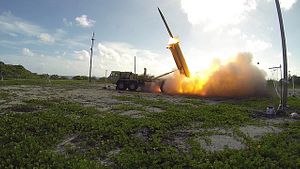With an alleged test of a thermonuclear device, a rocket launch, and a recommissioned plutonium reactor, 2016 is shaping up to be a very busy year for North Korea (DPRK). After years of delay and South Korean (ROK) opposition, the United States finally entered into formal discussions with the ROK government over the prospective deployment of the American-made Terminal High Altitude Area Defense (THAAD) system.
Critics bemoan the potential deployment as an unnecessarily aggressive move that reduces the chances for peace with North Korea and sours the relationship between Seoul and Beijing. It does not have to be. Deploying THAAD could make negotiations with North Korea more palatable to the United States and even act as a precursor to engagement.
First, THAAD deployment will further cement ties with the ROK. South Korean opposition stems primarily from concern over its relations with China, its largest trading partner and neighbor. Because THAAD undercuts Chinese missile capabilities, Beijing took extensive political and diplomatic measures to pressure Seoul into rejecting the missile defense system. Chinese leaders surmise that THAAD’s true target is China’s own missile arsenals. Admittedly, THAAD on the Korean peninsula will be able to track and intercept Chinese missiles. Nevertheless, this argument is unconvincing. The principal threat that undergirds the U.S.-ROK defense treaty is North Korea, and the reality is that the DPRK is now a nuclear-armed state with ever increasing delivery capabilities. Alliance policies should be formulated accordingly. If South Korea allows Beijing to dictate the terms of the alliance, it may give American policymakers doubts over future policy coordination with Seoul. Prospective engagement with North Korea sounds very unattractive if South Korea forces the U.S. to accommodate Chinese interests at every turn. Accepting THAAD deployment sends a strong message about alliance cohesion and provides Washington with the confidence that when push comes to shove, South Korea will stand with the U.S.
Beijing’s aversion to THAAD is fueled by concerns over regional stability. China’s reasoning would be more convincing if it discouraged North Korea from its aggressive development of nuclear weapons and ballistic missiles and its incessant provocations. This is hardly the case. In early 2012, during a military parade in Pyongyang, a number of North Korean ballistic missiles were ferried by six heavy transport vehicles. Because of the size and sophistication of these vehicles, they were suspected of being of Chinese origin. Also, in 2013, the United Nations Security Council, of which China is a permanent member, passed Resolution 2094, which restricted the flow of luxury goods into North Korea. Yet regime has imported $2 billion worth of luxury goods over the past three years, much of it coming from China. Even with the restrictions, imports rose from $644 million to $800 million from 2013 to 2014. It is evident that China will likely refrain from taking any measures that seriously threaten the integrity of the Kim regime.
THAAD can also help reassure the United States should it choose to pursue negotiations. Under the Clinton and Bush administrations, the United States attempted serious negotiations with North Korea over its nuclear program. Though the U.S. offered attractive terms to the embattled regime, North Korea responded by being notoriously uncooperative during the verification process and, ultimately, cheated on the agreement by developing a clandestine uranium enrichment program. It is understandable then that the U.S. expects complete and verifiable denuclearization as a precondition for negotiations. Deploying THAAD may encourage the U.S. to relax this precondition, knowing that there exists a safety-net should negotiations break down or if North Korea decides to cheat and expand its nuclear and missile programs once more.
Finally, THAAD adds value to the negotiation process as a future bargaining chip. Some analysts suggest deploying THAAD to shape China’s behavior. Alternatively, once deployed, the prospective removal of THAAD may be useful at the negotiating table with Pyongyang. Bargaining and sending messages through the deployment and withdrawal of weapons systems is by no means unprecedented. During August 2015, the United States and Germany announced the withdrawal of Patriot missiles from Turkey. The official explanation behind the decision cited the diminished threat of missile attacks by the Syrian Army and “critical modernization upgrades.” Further analysis revealed that Germany and the United States may also have been interested in expressing their displeasure at the divergence of Turkish attitudes regarding the Syrian conflict. Ankara had been targeting Kurdish forces on the same day it announced its intention to combat the Islamic State. Given the extremely limited channels of communication that the United States has with North Korea, THAAD deployment could be a novel way to “speak” to Pyongyang.
Sending THAAD to the Korean peninsula most obviously bolsters South Korean defenses. However, simply dismissing the looming deployment of the missile defense system as a mere exercise in antagonism can result in overlooking THAAD’s potential value to the peace process.
Harry H. Sa is a research analyst with the United States Programme at the Institute of Defence and Strategic Studies, a unit of the S. Rajaratnam School of International Studies (RSIS) based in the Nanyang Technological University, Singapore.

































